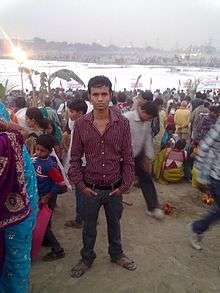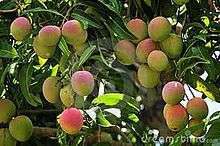Gaori village
Gaori
Gaori is a village of Saharsa district of north Indian state Bihar. It is the small village, by population but its area is not that small. It is surrounded by water channels namely Sathrath(which merges in Ganga) . While Saharsa holds an important place in the Kosi division, Gaori is credited for its numerous contributions to the district.
Society, religion, culture and safety
The village population consists of Maithil Brahmins mostly. There are various surnames (e.g. : saurabh jha gaurav jha chandarnath jha paban mishra etc..) found in this village, but jha and mishra surname mostly found in this village. So the group of jha surname peoples also known as "jha jee" . Brahmins, by definition of the social classification in ancient India, are the highest ranked. The Brahmins are traditionally supposed to have teaching as their profession. The original habitats of this village also called as Kujilvars or Dihvars (landlords) have the surname title as "jha and mishra " (a well known title of upper class Bengali) . They take pride in this title of jha or mishra. The most interesting and special thing is that villagers has very soft and kind heart After independence this population of Maithil Brahmins have been involved in all profession like Administration, Engineers, Doctors, farming, business, serving the military and para-military forces to name a few. Apart from Brahmins, many others belonging to the lower castes also reside (though many of these lower caste people are moving out to adjacent places to village as they need more space for their growing family). These include, dusaadhs, chamaars, Musahars, Kumhaars, Nauwa (nai) and Paseeba (a caste whose living comes through serving Nature+homemade alcoholic beverages called "Taari".). All these people mentioned before, are Hindus. However there is a small percentage of Muslims as well who mostly live in the Miyaaantoli last area of the village. These Muslims of the village rely predominantly on growing vegetables for their livelihood (often referred as Kujras). Some of the family members of these Muslim villagers also drive three-wheelers to make their ends meet. What characterises the Muslims of the village is the harmony they have kept for years. Gaori is perhaps the rare places both in India and abroad where such a communal harmony can be seen. Muslims do participate in Hindu festivals and Hindus put offerings to their Tazhiyaa, a sight not seen that easily in a world so barren of peace. Some of the marriages of boys and girls are performed within the village community itself and it is also expected from the well settled boys to marry a girl from the village itself. A rare event normally not seen anywhere in the country. It is blindly believed that sobhanath jha(sobhanath jha) guards the village from all the evils and those who follow the road to sin, are taken care of by him. It is for this reason, no outsider eyes targeting Gaori for committing crimes. The entire village is so well located that this area has not much been affected by the flood of Koshi river. Even in the worst flood of 1984 the main village was safe and the water entered in the outskirts of this village. The entire village is one piece of land in the Govt gazette and all disputes pertaining to the share of land among the families are resolved amicably within the village community. Also, the design of roads by the farsighted social reformer of the village, Late Ram Padarth Ji is acknowledged for the safety despite being so immensely populated. Sobhanath jha also founded the School in the village.
Land, farming and village life
Gaori and its surrounding areas are part of the Kosiriver basin.[1] This makes the land very fertile. The Kosi embankment is only 10 kilometers west. The farmers in the village mostly cultivate Dhaan (paddy crop), Makai (Maize/Corn), Gahum (Wheat crop) and Moong (a type of lentils) in their farms. Since the climate of this region is most suitable for Dhaan (the paddy crop), a good crop brings happiness to many farmers in the village. Though, people do try to grow wheat crops, only few farmers get good yields. Most of the farmers have moderate harvest and hence it is not as popular as harvesting of dhaan. Instead, maize is the second best crop for the farmers of this village. Therefore, they are tempted to grow garma dhaan (a unique type of paddy crop for summer farming) and makai (maize) crops together apart from harvesting regular crops. The timing of Dhaan harvesting is especially notable as the villagers are happy in general for several reasons.The reaping of the crop starts somewhere around mid November and is usually followed by some of the most important Hindu festivals namely Diwali and Shama Chakeba.[2] Six days after Diwali brings another festival called Chhath which is one of major festivals of Bihar. In between, Diwali andChhath is another festival that is known as Bhardootiya(Bhai Dooj) in which brothers go to see their sisters. After Diwali and Chhath one more local and important festival named as Shama Chakeba,[3] this festival also shows the bond between bhai (brother) and bahin (sister). So before the onset of the harvesting the festive mood is already set and green fields that start showing the golden shades of ripeDhaan crop are extremely pleasant to watch. Now for nearly two months it is the time for farmers to remain cheerful. The fresh crop ofDhaan reaches every home. Whether you are owner of the land, or the farmer or just the harvester, the Dhaan is bound to come to every household. It can be cooked straight or flattened to make Chura which makes an amazing food when combined with fresh Sakkar(Jaggery) and "Dahi" (Curd). In the rainy season (Savan aur Bhado) the whole agriculture land of this village is covered by rain water, so in this season the main food of the villagers fish and some aqua fruits.

Agriculture
The major crop of this village is rice. Other crops produced in this district are wheat, maize, pulses, oil seeds and sugarcane. The village is also famous for mango has many mango orchards.

Fruits And Vegetable
Among the all agricultural products that are grown in the village the most important is the mango crop, which is famous in Bihar in general and in Gaori in particular


Gaori's mango plantation can be distinguished by its unique and delicious taste. Recently, farmers have started to harvest the mango crop in the region. These mangoes are characterised nowadays by its acidulous taste and green colour. Locally the people like to eat these mangos when it is still juicy with a pinch of salt and dried red pepper, until gain its sweet taste and orange colour. In India, Dussehri and Langda varieties are most popular in the Northern states and in Gaori village various different varieties of Mangoes are cropped. The famous varieties of mangoes, which generally cropped in Gaori are listed below.
- Maaldeh
- Gulab Khash
- Zardalu
- Mallika
- Kesar
- Krishn Bhog
- Ram Bhog
- Faizli
- Kumal Pahad
- Bakia
There are various types of vegetables are also cropped in this village, such as cauliflower, potato, cabbage, green chilies, pea pods, etc. But cauliflower is main vegetable which is cropped as a large scale in this village.
Festivals and other functions
Of all the Hindu festivals, Holi, Krishnastami, Durga Puja, Diwali and Chhath are celebrated with full religious fervor. Others festivals likeRama Navami, Bhardutiya or Bhaiya dooj (Bhau-beej), Saraswati Puja, Kojagara, Sirua, Sama Chakeba etc. are also celebrated however not everybody seems involved hundred percent. On Diwali and Sama Chakeva, one mela (fair) is organised for 3 to 4 days, lots of sweets and toys shops also available in this mela and artists from other places are invited to perform.
Holi
The celebration of Holi is sometimes two-day long. The first day being Dhurkhel (playing with dirt and dusts) and the second day for colours. Sometimes both of these are performed on the same day. It is interesting to note that the Holi festival in this village is normally celebrated one day in advance to the rest of the country. During the Holi festival, people get to meet each other. Many people from this village who live in other cities of India and abroad come back home on this occasion to be with their family. Traditionally, people used to go in groups beating drums and singing Holi songs and Jogiras. This festival serves as an occasion to see each other and say Hi!! At few places, there are big stocks of bhang (an intoxicant made of cannabis in the form of Dudhbhanga milk laced with bhaang extracts and dry fruits), Tikri (a type of Indian sweet stuffed with bhaang) and bhangjilebi (another Indian sweet laced with bhaang). Elders are greeted with this intoxicant but youngsters also find a way to have this. This tradition of greeting people with bhaang at Dwar (a place where the gents guests are entertained) has been maintained by the family. It is interesting to note that in all Western countries possession of marijuana is a crime but here it is a substitute of alcohol as those who drink alcohol are looked down upon. People generally believe that bhaang is a favourite beverage of Lord Shiva and therefore is acceptable, by and large, in the society. Once the durkhel and the colours are over, there is some classical music program where artists from other places are invited to perform. The classical music program used to be very popular amongst elders but most of the youngsters wouldn't seem interested.
Diwali
Diwali or Deepawali is main festival where all the villagers can be seen participating. The major events of this festival are Naatak (Drama organised by villagers), Natua Naach (Dance Program), Mela (Fair). Because of Mela, many relatives from nearby villages visit. This is very popular for kids and younger people as well as females of the village. Kids go to this fair for buying toys that can't usually be bought because of the unavailability. For example, Digdigiya (a toy which has a drum attached to it and its plays when you move it), Cilema (kaleidoscope) Fukka (balloons) and many others. This kids also seem very interested in buying coloured goggles taking a ride of Jhoola (swing) and simply watching Maut ka Kuwaan (a motorbike stunt game). On the other hand females seem interested in shopping cosmetics and some household items. The elder males feel happy in taking their grandkids to the fair and shop for them. Usually elders are not seen shopping other than sweets and Paan. The writer of these lines still misses the Paan from Chaurasia Paan Bhandaar that used to come to the fair every year. During one of the mela nights, some artists from local orchestra parties would be invited. They would mostly play the peppy numbers. On some occasions a local male dancer